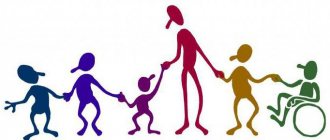Good day, dear readers of the CREATOR blog. I recently noticed that the site has not published materials on self-development and personal growth for a long time, so let’s correct it. In this article we will talk about 4 directions of human development.
Read also:
Where to start self-development | Plan, exercises, books and more
From all the directions and areas of life, I selected only 4 necessary in my opinion. These are physical, spiritual, intellectual and social-emotional components. If we devote one hour every day to the development of the listed areas, this will ultimately improve the quality and efficiency of all other hours of our lives.
No. 1. Physical development
What does physical development include?
The physical sphere implies constant concern for one’s own health. Here you cannot do without factors such as:
- Healthy eating;
- Sufficient rest;
- Regular exercise.
Let's talk about the latter in more detail.
Physical exercise
What prevents people from regularly monitoring their physical condition?
Most people find a reason not to exercise is that they do not have time for it. Seriously? We all have 168 hours a week. This means that at least 3.5 hours can be allocated to sports - i.e. 30 minutes a day.
Key Tip
And the most important thing here is that all this does not require special devices. To maintain good physical shape, you don't need to go to the gym or stadium. You don't have to buy gymnastic equipment. You don't have to play football or tennis.
You can perform a complete exercise program at home.
Physical exercises should develop the following parameters:
Endurance
Good endurance can be achieved through aerobics. This sport develops the cardiovascular system, which in turn increases the heart's ability to pump blood throughout the body.
List of exercises
Since we have established that the heart is the main organ that needs to be trained for endurance, let's look at suitable exercises for this.
Of all the muscle groups that are associated with the heart, I only know the legs. Therefore, the exercises are as follows:
- Fast run;
- Jogging;
- Cycling;
- Swimming;
- Skis;
- Walking in the mountains.
When can we say that endurance is satisfactory?
Endurance is considered well developed if you are able to maintain bullets up to one hundred beats per minute for thirty minutes.
Ideally, you should aim to increase your heart muscle contractions to 60% of your maximum.
Flexibility
Good flexibility can be achieved by stretching the muscles.
It is recommended to relax and warm up your muscles before each workout, preparing for intense exercise. After exercise, the muscles need to be properly stretched so that the lactic acid dissipates.
Force
Good physical strength can be achieved through simple gymnastic exercises to develop muscles. The basic ones include:
- Push ups;
- Pull-ups;
- Squats;
- Bars;
- Various exercises with weights.
Remember that the full benefit of any exercise occurs at the very end. So you need to repeat the exercise until you feel it in your muscles. At this point, the muscle tissue is torn and the nerves register pain. Due to pain, the muscles become stronger after 48 hours.
When you start exercising, your body will be against what is happening, especially for beginners. At first, the loads will not give you pleasure. You'll probably hate them. However, with proper self-discipline, your body will reward you with impressive results.
The mechanism of such a transition expresses another dialectical principle (law)
The category of quality in philosophy means a set of properties of an object. The category of quantity, which is paired with it, implies the relationship of qualitatively homogeneous objects. The unity of the quantitative and qualitative characteristics of a thing is captured by the category of measure. In other words, a measure is those boundaries, those limits within which quantitative changes do not cause a change in quality, i.e. the object remains itself. Every object has both quantitative and qualitative characteristics, and, therefore, there is a measure. But in order to see it, you need to force the object to change.
If, say, the size of a given book is reduced a couple of times, its main quality will be preserved - it will still be readable. But if you reduce it by a factor of a hundred, then it will cease to be suitable for reading and, therefore, will lose its main quality. The same is true when increasing the quantitative parameters of a given subject. The boundaries, or limits of quantitative changes, where a book will remain a book, are its measure. The dialectics of quantitative and qualitative changes implies the cause-and-effect nature of their relationship.
A certain amount of quantitative changes causes a change in the quality of a developing object. At the same time, quality significantly influences quantitative characteristics. Thus, the student’s gradual accumulation of knowledge ultimately leads to the emergence of a new quality of his personality - he becomes a specialist, a professional.
And this, in turn, assumes that the ongoing process of accumulating knowledge will continue to proceed more skillfully and rationally. The same fundamentality or central position of the principle of contradiction is also found in the construction of a system of other categories of dialectical thinking. Categories are extremely general, universal concepts, in which represent the universal connections and relationships of reality.
No. 2. Spiritual development
What is the spiritual dimension responsible for in a person’s life?
The spiritual sphere is a central part of our existence, which, through its development, leads a person to achieve leadership. The spiritual dimension is directly related to commitment to one's own values.
Everyone develops the spiritual sphere in their own way. Below we will look at the most popular ways to update and develop this dimension.
Ways of spiritual development and renewal
Some people find spiritual self-renewal in reading the Bible. Someone feels spiritual development in everyday meditation, or communication with nature. Some people are impressed by great literary or musical works.
The point of all spiritual renewal is to find time to think about the meaning of life, about the main purpose of our existence, about serving others, etc. The listed thoughts renew, refresh and reveal us over other areas of life.
Developing personal growth in the head and body
The time “X” comes and we begin to engage in personal growth and self-development.
Very often we are faced with the fact that we want to change everything. To do this, we begin to take care of ourselves, read a lot of books, go to trainings. And we don’t understand at all why changes in our lives are in no hurry to happen.
There is an expression among psychologists that “the internal tightens the external.” We can only agree with this if we actually do something for these changes.
Self-development always occurs at all levels: in the head and in the body. In other words, the inner always draws out the outer, and not vice versa. Self-development occurs in all areas of life:
- Physical
- Spiritual
- Intelligent
- Emotional
- Creative
What pushes us to change everything that is familiar to us. Yes, exactly, stressful situations that smoothly move from one to another and sometimes do not end at all or end in neurosis. Therefore, this is another reason to think about changes.
And some never come to change. They decided, for example, to reduce weight by 20 kg, but they do nothing at all, they just want to. And so they “waddle” from holiday to holiday, only having the desire to lose weight. Even diseases that are a consequence of excess weight do not stop a person. And he does not strive to start doing something, even in the name of his “health.”
Self-development is still a comprehensive work on oneself. And you need to have the willpower to start doing it.
No. 3. Intellectual development
What prevents people from developing intellectually and what benefit could there be from this?
In my opinion, the global problem of humanity is that most of us, after finishing traditional education, stop caring about developing our own intelligence. It gets to the point where our brains atrophy.
Look at yourself and your surroundings. Do you read self-development books? Maybe you are learning something new for yourself that goes beyond your professional interests? Do you set goals and put your thoughts on paper? I will be sincerely glad if among my readers there are those who do all this. For the rest, I advise you to read and think about the following thought.
Research has shown that on average Russians spend 4.5 hours on weekdays and up to 7-8 hours on weekends watching TV. Videos from YouTube are included here. This is almost the same amount they spend on work or school.
This would be a good indicator, it is a pity that television has a powerful social impact on people and not always in a positive direction.
Be disciplined and proactive to watch TV or YouTube videos wisely. Choose channels aimed at conveying useful information, self-education and entertainment. Make sure they align with your goals and values.
You can go further and find many other ways for intellectual development. Here are a few of them.
Reading
Why is it so important to read developmental literature?
There is no better way to constantly develop your own intelligence than reading good literature. In this way, you can maintain correspondence contact with great thinkers, communicate with the best minds of the past and present.
Set yourself a goal of reading one book a month.
“He who does not read is no better than he who cannot read.”
When reading, follow the most important advice - seek to understand first.
Letter
Ways to develop intellectually through writing
- Keeping a journal to record thoughts and ideas;
- Writing letters, whether paper or electronic;
These two options help develop clarity, precision, and meaningfulness in your thoughts.
Planning and Imagination
Planning, combined with imagination, can mentally organize the process of achieving goals. This is a training that helps develop a vision of the final goal and the entire path to it, while at the initial stage.
“Victory in any war is won in the general’s camp tent.”
What is personal growth and self-development?
American psychologist Carl Rogers in 1959 answered the question of what human personal growth is. He identified the general “law of personal growth” based on the “if-then” formula. It sounds like this: if the necessary conditions exist, then the process of self-development is actualized in a person, that is, changes aimed at his personal maturity.
- It is a constant and never-ending process of learning something.
- Thanks to this, a person grows and develops both qualitatively and quantitatively, noticeable changes occur
- Knows yourself better and improves your personal qualities
- Gains new skills and finds his purpose
- Improves quality of life and lives more consciously and interestingly
- Life becomes more harmonious, and this makes it joyful and happy
This is, in fact, the most profitable investment - an investment in your self-development, personal growth.
Growth is always quantitative changes that a person can track himself, and development is qualitative changes; as a rule, the environment takes part here.
What gives a person personal growth?
- Get out of stress
- Financial stability
- Recovery from depression and nervousness (from illness)
- Relationships normalize, it happens that people next to you begin to grow or leave
- Getting rid of addiction
- Marriage
- Feeling good
The development of personal growth first of all changes a person’s consciousness. If, for example, he wanted to lose weight and couldn’t, then first of all he changed a lot of existing attitudes in his head to others (psychological ways of influencing his body). Physically changed my habits, started eating healthy and adjusted my lifestyle. Time needs to pass. And only then can you count on results.
How psychology affects physiology
The starting point is always in your head. Analysis of events can be carried out independently or better with a psychologist. Each time you delve into “adverse events,” you can become completely bogged down in them. And not only fail to pull yourself out of stress, but, on the contrary, get even more bogged down.
Therefore, it is better to do all this with a psychologist who will competently guide you through all the labyrinths of your memory and help you correctly adjust these settings.
No. 4. Social-emotional development
What is social-emotional development?
The social-emotional dimension manifests itself in everyday interactions with other people. This leads to the conclusion that social-emotional development does not require special time investment. It can be carried out during a normal conversation with friends, colleagues, relatives, children, etc.
But this also requires effort and special skills. The main feature is that you need to act not with your intellect, but with your emotions.
Ways that can help develop the social-emotional dimension
- The first way is to listen, not with the goal of answering, but with the goal of understanding and feeling yourself in the other person’s place. Listen so that you can express the other person's point of view in your own words.
- The second way is when discussing any decision, try to come to a third alternative. The third alternative is a solution that will satisfy both of you.
- The third way is to live by Win/Win. This means that the success of one does not exclude the success of others. Strive for it.
Conclusion
The comprehensive development of preschool children lays the foundation for further successful and harmonious education. It is clear that with the current rhythm of life there is not always enough time to fully engage with the child. And if you have to delegate the care of him, it would be better if it was a modern center that unobtrusively and in a playful way gives the child the necessary skills.
The programs of children's clubs and kindergartens "Baby Club" take into account all the above aspects, and our teachers do everything possible to raise life-oriented, smart and well-rounded children.
A well-rounded child has every chance of successful study and career in the future.
Ontogenesis is a gradual change in the organism, occurring in stages in the form of quantitative and qualitative shifts, from a less to a more perfect structure and functioning.
Ontogenesis, in essence, of this concept should be attributed to the entire period of a person’s life from birth to death, that is, include not only progressive, but also regressive, involutional changes. But more often they talk about ontogenesis in relation to childhood, and it is in this sense that this concept is used In chapter.
Each stage of ontogenesis constitutes a transition from one qualitative state of the organism to another, higher one by transforming its functioning without displacing the qualitative level of the previous stage. In other words, in the body there is a gradual differentiation of certain (including mental) processes with their simultaneous integration into a new whole In the psychological aspect, this is an increase in the mental content of the personality
The periodization of the development of the human body, introduced by K. Behr back in the last century (1826), subsequently became widespread. It formed the basis of modern ideas about the stages (stages, phases) of the development of the body
In domestic and world practice, 4 main stages of psychophysical development
in childhood - from birth to 14 years The first stage is early (from 0 to 3 years), the second is preschool (from 4 to 6 years), the third is school (from 7 to 10 years), the fourth is puberty, or rather school- puberty (from 12 to 14 years). In addition to the stated stages, the medical literature often uses the concept of “children” and “adolescents.” The adolescence period includes the period of life from puberty to adulthood (youth) - most often the age of 12-16 years is meant, but sometimes it is expanded - 11-17 years.
The process of ontogenesis in childhood also includes the so-called critical periods, or transition from one stage of development to another. It is customary to distinguish 3 critical periods
I - from 2 to 4 years, II - from 7 to 8 years and III - puberty - 12-14 years. Critical periods are short periods of time characterized by rapid changes in the functioning of the body, general and mental reactivity. They are of great interest for clinical medicine, since these changes cause an increased risk of the occurrence of any diseases, including mental ones, and contribute to the aggravation of their course.
The normal mental development of a child is a complex process, which is based on a species-specific and genetic program that is implemented under conditions of constant change in environmental factors. Mental development is closely related to the biological properties of the body, its hereditary and constitutional characteristics, congenital and acquired qualities, mediated by the gradual formation of the structure and function of various parts of the central nervous system. The rates of formation of individual brain systems are different and this determines the physiological heterochrony of its growth and development, reflected in different rates of maturation of individual psychophysiological functions. These differences also include individual variations.
The main factors influencing mental development include heredity, family environment and upbringing, as well as the external environment with the diversity of its social and biological influences. All these influences act in a single complex, which can determine both the strengthening and leveling of the influence of each factor.
In recent decades, interest in psychology, neurology and psychiatry of early childhood has increased in domestic and foreign medicine [Badalyan L. O., Zhurba L. T., 1980; Lisina M.N., 1980; Mastyukova E. M., 1980; Shevchenko B. S., 1993; Kozlovskaya V. G., 1996; Goryunova A.V., 1997; Anthony E., 1982; Greenspan S., 1992; Stern D., 1994].
In the psychogenesis of early life, the following stages were additionally identified: the neonatal period
(age 1-1.5 months);
infancy
– period up to 1 year;
toddler period
- 2nd and 3rd years of life. Critical periods were also identified - prenatal and early childhood: 15-25 and 28 weeks of pregnancy, III trimester of pregnancy (30-40 weeks), prenatal period (3-5 days before birth) and childbirth, neonatal stage (1 -1.5 months), age 6-8 months, age 15-17 months and age 2.5-3.5 years.
The given periodization was initially identified empirically by psychologists and doctors, but then it was confirmed in special neuropsychological, neuromorphological and neurophysiological studies [Borovova A. I., Galkina N. S., 1992; Stroganova T. A., 1995; Hersckowitz N., 1990].
From the point of view of neuromorphology, the critical periods of early childhood represent, as it were, the peak of structural transformations occurring at the corresponding stage. Thus, the critical period of 15-28 weeks of intrauterine development of the fetus corresponds to the formation of subcortical structures of the brain, 28 weeks - the formation of structures of the cerebral cortex. Psychologically, the third trimester of pregnancy is characterized as the appearance of elements of auditory memory and correlations of fetal behavior with the mental state of the mother.
The prenatal period and childbirth combine hibernation, or preparation for the act of childbirth in the form of prenatal suspended animation of the fetus, and childbirth itself is equated in relation to the fetus to stress, which causes in it a state of deep nervous and psychophysical tension, associated with the possibility of transformation into a reaction of distress with risk development of one or another pathology.
The first month of life, or the neonatal period, correlates with the beginning of an undifferentiated perception of one’s self. The first days of a child’s life, which are characterized by the Konrad Lorenz imprinting phenomenon, or the “imprinting” phenomenon, are of particular importance in it. We are talking about the first contact of a newborn, eye-contact with a human face, primarily with the mother. It is believed that this contact is a factor that largely determines all further mental development of the child.
The next sensitive stage of the newborn period is the age of 3-4 weeks. It is also called the period of primary social behavior in the form of eye contact with the outside world (early-eye-contact baby). This period is characterized by the development of primary positive and negative feelings and ideas about the world around us.
The critical period, attributed to the age of 6-8 months, is determined by the beginning of differentiation of the sense of self, individualization of the self, as well as the beginning of the formation of primary attachment, selective “smile” and elementary social preferences.
The critical period at the age of 15-17 months is determined by the appearance of primary motivation for behavior, determined mainly by the vital needs of the body, and then secondary motivation, characterized by an orientation towards the assessment of behavior by others and the gradual identification of positive behavioral experience with the approval of people close to the child. During the critical period under consideration, the described features appear, but their formation within it, naturally, does not end and their development continues at an older age. It should also be noted that at 15-17 months, intensive maturation of the cells of the cerebral cortex occurs (it begins at 28 weeks of pregnancy and continues until adolescence - 18-20 years). This also corresponds to significant changes in biological brain rhythms, which is reflected in electroencephalographic characteristics.
The last critical period of early ontogenesis, as already indicated, refers to the age of 2.5-3.5 years. It is defined as the period of formation of self-awareness, complete separation of the Self and individuality. At this stage, the child already has not only positive, but also negative experience of relationships with the outside world, with feelings of threat, anxiety, guilt and low mood. But the most significant changes for this period are the changes associated with the transition from a full and partial symbiotic relationship with the mother to a sense of independence. It is no coincidence that this period is sometimes called “revolutionary” and “the first pubertal crisis” [Badalyan L. O., 1975; Manova-Tomova V., Pirvov G., 1981; Wolff S., 1989].
Dysontogenesis
is a violation of the development of an organism at any stage of ontogenesis
. Mental dysontogenesis -
pathology of mental development with changes in the sequence, rhythm and pace of the process of maturation of mental functions. The development of the content of this concept in domestic child psychiatry is associated with the names of G. E. Sukhareva, M. Sh. Vrono, G. K. Ushakov, V. V. Kovalev, A. E. Lichko.
In clinical psychiatry, the term “dysontogenesis” refers to delays and distortions of mental development. The group of disorders united by the concept of “mental retardation” includes pathological conditions characterized by insufficient intelligence and the psyche as a whole. “Distortions of mental development” include conditions characterized by partial and dissociative development of mental functions. Some of them may be characterized by acceleration, while others may be characterized by delayed development.
Delays in mental development should be distinguished from acquired states of personality defect and intellectual activity due to a disease process or other damage to the psyche. In the latter case, it is customary to talk about dementia, or dementia.
Within the framework of mental underdevelopment, a distinction is made between severe mental states (retardation) and relatively mild mental development delays (borderline forms of developmental delay).
Dysontogenesis of mental development can occur under the influence of many internal and external factors (genetic, biological, psychogenic and microsocial), as well as their combination and interaction. Among the main ones can be named residual organic cerebral insufficiency, which in foreign literature is defined by the capacious concept “ minimal brain dysfunction" (minimal brain dysfunction - MBD). When specifying these factors in relation to early childhood, attention is paid to the characteristics of temperament, somatic and organic cerebral pathology, a complex of emotional attachments, deprivation (including partial orphanhood - the death of "one of the parents , divorce).
Temperament factor
begins to act and is determined from the 1st month of the child’s life. Nine components of temperament have been identified: activity, rhythm (cyclicity), sensitivity (reactivity), intensity, mobility, communication, adaptability, mood, attention (its volume). Each of these characteristics determines the child’s different behavior and reactions in any life situation. Based on the type of infant’s reactions when studying temperament, one can identify a group of so-called difficult children who are predisposed to mental dysontogenesis.
Traditionally, organic factors for the occurrence of dysontogenesis have been considered. include cerebral pathology,
structural, i.e. organic brain lesions and functional disorders of brain activity. But with the latter, the presence of “soft” organic signs is allowed. It is in this case that we speak of the already mentioned minimal brain dysfunction.
The last two factors of dysontogenesis are a complex of emotional attachment
and
deprivation
are essentially psychosocial and closely related. The connection between the child and mother that arises from the first hours and days of a newborn’s life has a decisive influence on the formation of all other connections and attachments and their varying emotional depth, which largely determine the psychological reactivity and behavior of the individual throughout life.
Deprivation can be complete or partial, sensory and emotional. But in any of the variants, it has a great influence on the mental development of the child, leading to its disruption, i.e. dysontogenesis.
Manifestations of mental dysontogenesis are varied. According to M. Sh. Vrono (1983), the clinical picture of mental dysontogenesis depends primarily on the age of the child and, accordingly, on the stage of ontogenesis, i.e. the author emphasizes the chronogenic aspect of dysontogenesis.
V.V. Kovalev (1981) distinguishes 4 types of dysontogenesis: 1) delayed or distorted mental development; 2) organic dysontogenesis - as a result of brain damage in the early stages of ontogenesis; 3) dysontogenesis due to damage to individual analyzers (vision, hearing) or sensory deprivation; 4) dysontogenesis as a result of a lack of information from an early age due to social deprivation (including improper upbringing). Recognizing the variety of types of mental dysontogenesis, V.V. Kovalev nevertheless combines them into 2 main options - dysontogenesis with negative symptoms and dysontogenesis with productive syndromes. He includes the first syndromes of mental underdevelopment - total (oligophrenia) and partial retardation (mental retardation), acceleration, various forms of infantilism, and neuropathy. The second option includes cases when, against the background of clinical manifestations of negative dysontogenetic disorders, productive phenomena develop: fears, pathological habitual actions, enuresis, encropresis, increased sloppiness, loss of walking, speech, self-care skills, transition of mental functioning to earlier stages of development, as well as affective disorders, drive disorders, hyperactivity, pathological fantasy, heboid, catatonic and other syndromes.
Thus, the main forms of dysontogenesis include mental development delays (total and partial) and mental development distortions (acceleration, infantilism, etc.).
Recently, another form of mental dysontogenesis has been identified - diathesis, which is an expression of a predisposition to certain mental illnesses [Anufriev AK Kozlovskaya GV 1985; Tsirkin S.Yu., 1995].
In psychiatry, schizotypal diathesis is the most studied as a clinical expression of a genetic predisposition to schizophrenia [Kozlovskaya G. V. Goryunova A. V., Rimashevskaya N. V., 1986]. Theoretically, the identification of nonspecific mental diathesis as a prerequisite for other mental disorders is justified [Tsirkin S. Yu., 1995].
Thus, mental dysontogenesis is a group of mental disorders observed in childhood, classified as so-called evolutionary pathological conditions [Kovalev V.V., 1982].
Mental disorders during dysontogenesis differ from such developmental anomalies as post-processual (post-schizophrenic) defect, dementia due to organic cerebral disease. In these cases, mental dysontogenesis is one of the syndromes of the underlying disease. The syndrome of immaturity of neuropsychic functions in the form of delayed psychomotor development is one of the main psychoneurological, undifferentiated formations in the structure of diseases not only of the nervous system, but also of chronic, somatic pathology, including hereditary ones. Disorders of mental development that occur at an early age may underlie mental disorders that develop at an older age.
Clinical forms of pathology of mental development can be systematized as follows:
- Mental retardation
- Mental development delays (borderline and partial)
- Distortions and other mental development disorders
- Autistic disorders
- Acceleration
- Infantilism
- Somatopathies
- Special forms of mental dysontogenesis in children from high-risk groups for mental pathology
This taxonomy is somewhat different from that given in many textbooks on child psychiatry, including the taxonomy of M. Sh. Vrono in the manual edited by A. V. Snezhnevsky (1983). The introduction into it as a separate group of disorders reflecting distortions of mental development is justified by the results of many years of research begun by O. P. Yuryeva (1970) and continued by G. V. Kozlovskaya et al. (1986, 1995), which made it possible to trace the dynamics of children’s development from birth to adolescence and beyond and showed the uniqueness of certain forms of mental development disorders (especially in children at high risk for mental pathology).
The given clinical forms of pathology of mental development in ICD-10 are included in 3 sections: “Mental retardation” (headings F70-79), “Disturbances of psychological development” (P80-89), “Behavioral and emotional disorders beginning in childhood and adolescence” (F90-98).
A common feature of mental disorders in children, especially in infancy, is a combination of manifestations of the progressive dynamics of development of mental functions and their dysontogenesis, caused by a violation of the formation of morphofunctional systems of the brain. These types of disorders may be the result of congenital characteristics of the nervous system, cerebral distress and microsocial influences. In this age period, the hypothesis about the three-axis, or three-level, structure of the etiology of mental illnesses is confirmed, when three types of factors of equal causal significance interact - genetic, exogenous-cerebral and psychosocial, which is reflected in the polymorphism of the clinical picture and makes it necessary to implement an individual approach to construction of therapeutic and preventive measures [Kozlovskaya G.V., Bazhenova O.V., 1995].
Neural connections and self-talk
New neural connections do not appear immediately. You need to work on them. Therefore, there must be new skills and new knowledge to know how to change everything. Physiologically, the body and head must get used to these changes.
And to understand that they are good for you, you must be calm and happy. And here, too, you can use the technique of “talking to yourself.” About the fact that “it’s like this for now, but everything is moving towards a better, more profitable and more fun life.”
Any habit takes root within three weeks or a month. Therefore, do not sabotage, but simply gradually introduce this habit into action. Soon it will become your reliable support on the path to change. For example, repeating a new habit over and over again will reinforce it in your brain.
Talking to yourself
Qualitative and structural changes in the economy
Previously, we found out what development is in general, and now we will focus on such a variety as economic progress. This is a very important set of various processes that influences the level and quality of life, progress in science, education and culture, as well as the labor productivity of the population. What economic development is was defined by J. Schumpeter in 1911. He published a book called The Theory of Economic Development. It pointed out the differences between economic development and growth, and also defined and classified the essence of innovation in various types.
Internal incentives for personality development
An indispensable condition and driving forces for the development of an individual are the growth of his mental capabilities and needs, their contradiction with the old ones. The insufficiency of internal and external means pushes a person to search for new, adequate ways to satisfy increased demands - forced or conscious assimilation of new knowledge, skills and abilities occurs, and a sensory, emotional perception of the world develops.
Then the process repeats: the acquired experience becomes outdated and the need arises to resolve requests of a new, higher level. As a result, connections with others become more conscious, selective, and diverse.
The concept of personality
The words “person” and “personality” are not synonymous. Let's compare their values.
Humans are biological beings with innate physical characteristics. The conditions for its development are favorable external factors: warmth, food, protection.
Personality is a result, a phenomenon of social development, in which consciousness and self-awareness are formed. It has certain psychological and physiological properties acquired as a result of development and upbringing. Psychologists believe that personal qualities emerge only as a result of social relationships.
Each personality is unique, possessing only its own inherent positive and negative qualities. Each person has his own life goals and aspirations, intentions, reasons and motives for action. In choosing means, he is guided by his own circumstances and views on morality. An antisocial personality, for example, does not know or does not recognize generally accepted moral standards and is guided in his actions by selfish goals. Irresponsibility, conflict, a tendency to blame others for one’s own failures, and the inability to learn from one’s own mistakes are characteristic features of such a person.










